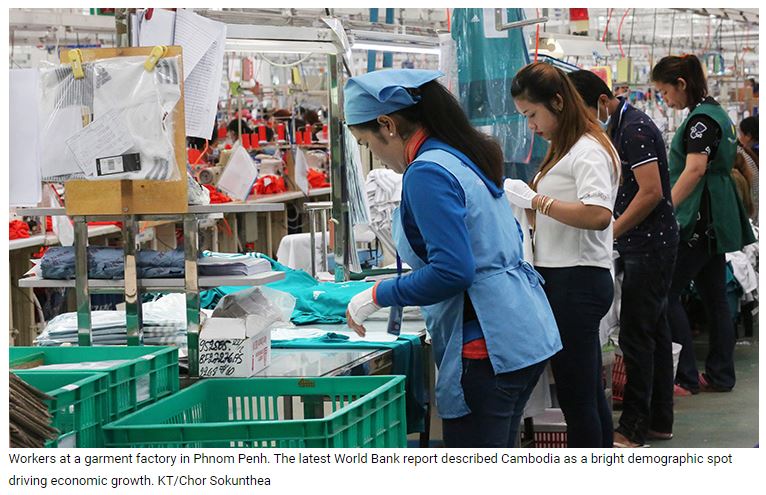WB cites Cambodia’s demographic advantage
Along with a couple of other Asean countries, Cambodia remains a bright demographic spot driving economic growth, said the latest World Bank (WB) report which, however, warned of a slump in global growth for the remainder of this decade.
In a report titled ‘Falling Long-Term Growth Prospects: Trends, Expectations, and Policies,’ World Bank on Monday said that across the world, a structural growth slowdown is underway and at current trends, the global potential growth rate is expected to fall to a three-decade low over the remainder of the 2020s.
“Nearly all the forces that have powered growth and prosperity since the early 1990s have weakened, not solely because of a series of shocks to the global economy over the past three years. The growth rates of investment and productivity are declining. The global labour force is ageing and expanding more slowly. International trade growth is much weaker now than it was in the early 2000s,” the report said.
However, it said that several economies in the East Asia and Pacific (EAP) region such as Cambodia, Indonesia, Lao PDR, Malaysia, Myanmar, Papua New Guinea and the Philippines are still enjoying a demographic dividend.
For Cambodia, Lao PDR, and Papua New Guinea, increases in working-age populations are expected, and these countries could continue to reap demographic dividends if they generate sufficient jobs, the report pointed out. The largest decline in the share of the working-age population is expected in China in the region.
For the EAP region as a whole, labour force participation rates and productivity have been boosted by an increase in secondary school completion rates of 10 percentage points between 2000-10 and 2011-21, a rise in the tertiary enrollment rate of 14 percentage points and improvements in health reflected in an extension of life expectancy by two years.
The report also noted that the region’s rapid growth in recent decades had been largely fuelled by labour and other resources moving from agriculture to higher-productivity sectors – a process that has encouraged urbanisation.
EAP has the potential for continued, rapid urban development, the report said, but added that the share of people living in urban centres was only 57 percent in 2020 – well below the advanced economy average of 80 percent.
Urbanisation is particularly low in Cambodia at 21 percent as well as Myanmar and Vietnam at around 35 percent. It is only 13 percent in Papua New Guinea.
With much of the region’s workforce still engaged in agriculture, there is still scope for substantial productivity gains from resource reallocation, particularly in Cambodia, Indonesia, the Philippines, Timor-Leste, Thailand and Vietnam, the report said.
To promote further urbanisation, World Bank recommended measures including investing in infrastructure and social services, making land more accessible on a fair and transparent basis, encouraging facilities that support recent migrants and coordinating urban services across municipal boundaries.
At the same time, improving the business climate would also help raise productivity in some economies such as Cambodia, Lao PDR, Fiji, Myanmar, Papua New Guinea, Timor Leste and small Pacific islands.
But Cambodia, Lao PDR, Myanmar and Papua New Guinea rank low on the Corruption Perception Index produced by Transparency International and on other governance indicators, it said, adding that enhanced transparency, strengthened accountability and greater responsiveness of state institutions to the needs of the private sector would bolster investor confidence.
The report also spoke of a persistent and broad-based decline in long-term growth prospects hampering the ability of Emerging Market and Developing Economies (EMDEs) to combat poverty, tackle climate change and meet other key development objectives.
“These challenges call for an ambitious policy response at the national and global levels. The slowdown can be reversed by the end of the 2020s — if all countries replicate some of their best policy efforts of recent decades and accompany them with a major investment push grounded in robust macroeconomic frameworks,” the World Bank report said.
Source: https://www.khmertimeskh.com/501263880/wb-cites-cambodias-demographic-advantage/


 Thailand
Thailand




